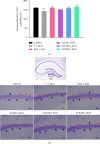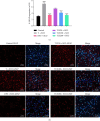Tacca chantrieri André Rhizome Extract Alleviates Scopolamine-Induced Cognitive Impairment and Neuroinflammation in Rats
- PMID: 40458441
- PMCID: PMC12129611
- DOI: 10.1155/adpp/7334303
Tacca chantrieri André Rhizome Extract Alleviates Scopolamine-Induced Cognitive Impairment and Neuroinflammation in Rats
Abstract
Tacca chantrieri André is a native plant from Northern Thailand with reported pharmacological effects, including antioxidant, anti-inflammatory, and neuroprotective properties. This study investigated the neuroinflammatory and cognitive-enhancing effects of Tacca chantrieri André rhizome extract (TCE) in a scopolamine-injected model, which mimics an Alzheimer's disease (AD) animal model. Animals were divided into six groups: (1) a control group, (2) a vehicle-treated group, (3) a donepezil-treated group (3 mg/kg BW) as a positive control, and (4-6) three TCE-treated groups receiving 50, 100, or 200 mg/kg BW once daily for 14 days. Starting on Day 8, animals received daily intraperitoneal injections of scopolamine (3 mg/kg BW) for 7 consecutive days to induce cognitive impairment. On day 14, behavioral tests were conducted, including the Y-maze and open field tests. On day 15, animals were euthanized, and their brains were collected for Nissl staining, immunofluorescence staining, and biochemical analyses using an ELISA kit. Our results demonstrated that TCE treatment attenuated scopolamine-induced memory deficits and neuroinflammation. Specifically, TCE administration reduced levels of proinflammatory cytokines, including tumor necrosis factor-α (TNF-α) and interleukin-1β (IL-1β), and decreased glial fibrillary acidic protein (GFAP) expression in the hippocampus. Additionally, TCE improved neuronal survival and enhanced serotonin levels, contributing to cognitive improvements. The qualitative analysis of TCE using LC-QTOF-MS identified various chemical constituents, including saponins, flavonoids, and phenolic compounds. These bioactive compounds contributed to the neuroprotective effects of TCE by modulating neuroinflammation and cognitive function. The neuroprotective effects of TCE suggested its potential as a therapeutic agent for memory impairment associated with AD.
Keywords: GFAP; Tacca chantrieri; memory; neuroinflammation; proinflammatory cytokine; scopolamine; serotonin.
Copyright © 2025 Thaneeya Hawiset et al. Advances in Pharmacological and Pharmaceutical Sciences published by John Wiley & Sons Ltd.
Conflict of interest statement
The authors declare no conflicts of interest.
Figures







Similar articles
-
Gallic acid enhances memory, learning and reduces neuroinflammation in a rat model of scopolamine-induced cholinergic dysfunction.Inflammopharmacology. 2025 Apr;33(4):2095-2108. doi: 10.1007/s10787-025-01699-w. Epub 2025 Mar 16. Inflammopharmacology. 2025. PMID: 40090981
-
Ambroxol Improves Amyloidogenic, NF-κB, and Nrf2 Pathways in a Scopolamine-Induced Cognitive Impairment Rat Model of Alzheimer's Disease.Drug Dev Res. 2024 Nov;85(7):e70017. doi: 10.1002/ddr.70017. Drug Dev Res. 2024. PMID: 39533780
-
Lantana camara leaf extract ameliorates memory deficit and the neuroinflammation associated with scopolamine-induced Alzheimer's-like cognitive impairment in zebrafish and mice.Pharm Biol. 2023 Dec;61(1):825-838. doi: 10.1080/13880209.2023.2209130. Pharm Biol. 2023. PMID: 37212299 Free PMC article.
-
The Revival of Scopolamine Reversal for the Assessment of Cognition-Enhancing Drugs.In: Buccafusco JJ, editor. Methods of Behavior Analysis in Neuroscience. 2nd edition. Boca Raton (FL): CRC Press/Taylor & Francis; 2009. Chapter 17. In: Buccafusco JJ, editor. Methods of Behavior Analysis in Neuroscience. 2nd edition. Boca Raton (FL): CRC Press/Taylor & Francis; 2009. Chapter 17. PMID: 21204339 Free Books & Documents. Review.
-
Neuroprotection effect of bovine umbilical mesenchymal stem cell-conditioned medium on the rat model of Alzheimer's disease mediated by upregulation of BDNF and NGF and downregulation of TNF-α and IL-1β.Open Vet J. 2025 Jan;15(1):151-161. doi: 10.5455/OVJ.2025.v15.i1.14. Epub 2025 Jan 31. Open Vet J. 2025. PMID: 40092207 Free PMC article. Review.
References
LinkOut - more resources
Full Text Sources
Miscellaneous
